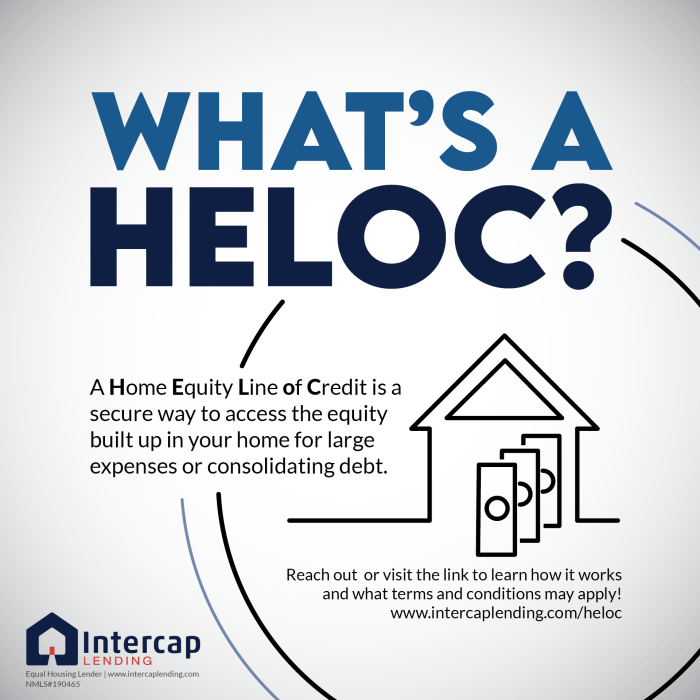
Navigating the world of personal finance can be a daunting task, especially when faced with significant borrowing decisions. Two common avenues for securing funds are Home Equity Lines of Credit (HELOCs) and student loans. While both offer access to capital, their terms, implications, and suitability vary drastically. This comparison delves into the key differences between HELOCs and student loans, empowering you to make informed choices aligned with your financial goals.
Understanding the nuances of interest rates, repayment structures, tax implications, and long-term financial impact is crucial. We’ll explore the advantages and disadvantages of each loan type, considering factors such as credit score impact, permissible uses of funds, and potential risks. By the end, you’ll possess a clearer understanding of which financing option best aligns with your individual circumstances.
Interest Rates and Repayment Terms

Understanding the interest rates and repayment terms for both Home Equity Lines of Credit (HELOCs) and student loans is crucial for making informed financial decisions. These loan types differ significantly in their interest rate structures, repayment schedules, and associated fees, impacting long-term financial planning. This section will compare and contrast these key aspects.
Interest Rate Comparisons
HELOC and student loan interest rates vary greatly depending on several factors, most notably the borrower’s credit score and the loan amount. Generally, borrowers with higher credit scores qualify for lower interest rates. Larger loan amounts may also result in slightly higher rates due to increased risk for lenders.
For example, a borrower with an excellent credit score (750 or above) might secure a HELOC with an interest rate around 6% to 8%, while a borrower with a fair credit score (660-699) might face a rate of 9% to 12% or higher. Similarly, student loan interest rates depend on the type of loan (federal or private), the borrower’s creditworthiness, and the loan’s disbursement date. Federal student loans typically have lower, fixed interest rates than private student loans, which often have variable rates influenced by market conditions. A student with excellent credit might receive a private student loan with a rate of 6% to 8%, while a student with a lower credit score might see rates exceeding 10%. These are illustrative examples; actual rates vary significantly based on lender policies and market conditions.
Repayment Structures
HELOCs typically offer a draw period, during which the borrower can withdraw funds as needed, followed by a repayment period. During the draw period, interest-only payments are often required. Once the draw period ends, the borrower must repay both the principal and interest. The length of the draw period and the repayment period varies depending on the lender and loan terms. Student loans, on the other hand, often have a fixed repayment schedule from the outset. Repayment plans vary, but common options include standard repayment (fixed monthly payments over 10 years), extended repayment, graduated repayment, and income-driven repayment.
Fixed vs. Variable Interest Rates
HELOCs commonly have variable interest rates, meaning the interest rate fluctuates based on market conditions. This creates uncertainty in monthly payments and makes long-term financial planning more challenging. Fixed interest rates, typically found in some student loans, provide predictability and stability, making budgeting easier and reducing the risk of unexpected payment increases. The choice between fixed and variable rates should be carefully considered based on the borrower’s risk tolerance and financial outlook.
Repayment Term Comparison
| Feature | HELOC | Student Loan (Federal) | Student Loan (Private) |
|---|---|---|---|
| Interest Rate Type | Typically Variable | Fixed | Fixed or Variable |
| Minimum Payment | Interest-only during draw period; principal and interest during repayment period. Varies by lender. | Varies by repayment plan; typically a fixed monthly amount. | Varies by lender and repayment plan. |
| Amortization Schedule | Typically amortized over a set number of years during the repayment period. | Standard plans are typically 10 years; longer plans are available. | Varies by lender and loan term. |
| Early Repayment Penalty | May or may not apply; varies by lender. | Generally none for federal loans; may apply to private loans. | May apply; varies by lender. |
| Late Payment Penalty | Usually applies; varies by lender. | Usually applies; varies by lender and loan type. | Usually applies; varies by lender. |
Final Wrap-Up

Choosing between a HELOC and a student loan requires careful consideration of your financial situation, short-term needs, and long-term aspirations. While student loans are specifically designed for education, HELOCs offer flexibility for various purposes but come with inherent risks tied to your home equity. By weighing the pros and cons of each, including interest rates, repayment terms, tax implications, and potential risks, you can make an informed decision that supports your financial well-being. Remember to consult with a financial advisor for personalized guidance tailored to your unique circumstances.
Helpful Answers
What is the minimum credit score typically required for a HELOC?
Lenders typically require a credit score of at least 660 for a HELOC, though higher scores often qualify for better interest rates.
Can I use a HELOC for anything I want?
While HELOCs offer flexibility, lenders may place restrictions on how the funds can be used. Some may prohibit using the funds for illegal activities or high-risk investments.
What happens if I default on a student loan?
Defaulting on a student loan can have severe consequences, including damage to your credit score, wage garnishment, and potential legal action.
Are there any fees associated with HELOCs or student loans?
Both HELOCs and student loans may involve various fees, such as origination fees, annual fees, and late payment fees. These fees can vary significantly depending on the lender and loan terms.
